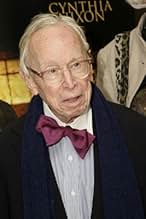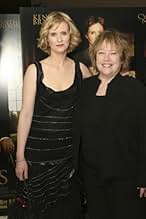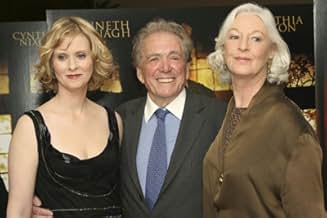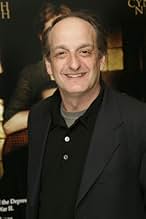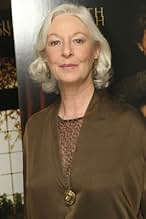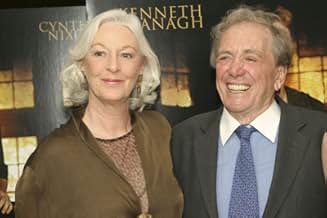CALIFICACIÓN DE IMDb
7.4/10
3.5 k
TU CALIFICACIÓN
Agrega una trama en tu idiomaThe stirring true story of Franklin D. Roosevelt's battle with polio in 1921.The stirring true story of Franklin D. Roosevelt's battle with polio in 1921.The stirring true story of Franklin D. Roosevelt's battle with polio in 1921.
- Ganó 5 premios Primetime Emmy
- 12 premios ganados y 42 nominaciones en total
Matt O'Leary
- Fred Botts
- (as Matthew O'Leary)
Andy Davoli
- Jake Perini
- (as Andrew Davoli)
Brian F. Durkin
- Elliott Roosevelt
- (as Brian Durkin)
- Dirección
- Guionista
- Todo el elenco y el equipo
- Producción, taquilla y más en IMDbPro
Opiniones destacadas
10jotix100
This is a film that only Joseph Sargent could have directed. Mr. Sargent's work has been basically seen on television. This HBO film deals directly with Franklin D. Roosevelt's battle with polio. As written by Margaret Nagle, the film is rewarding in that one sees an aspect of this great man in human terms.
Mr. Roosevelt was a man that came from wealth and privilege. The Roosevelts and the Delanos were involved in politics most of their lives. When we first meet F.D.R. and his family, we find then living under the influence of his bossy mother, Sara Delano. His wife Eleanor is no fool, she soon realizes her husband is having affairs with other women. Eleanor's mother-in-law quickly takes command of things as she reminds the younger woman that some great men have mistresses outside the home, but that it shouldn't be a cause for a divorce, something that wouldn't have been Franklin's political death, at the time.
We watch in horror how Mr. Roosevelt is stricken with polio. In spite of his political savvy, Franklin is not ready to accept what has befallen him. With the reluctant aid of Eleanor, he answers an invitation to go to rural Georgia, to Warm Springs, where the owner has written him, some progress has been seen on people with suffering polio.
Warm Springs is more backward than what the Roosevelts expected. Franklin is determined to make a go of it. Helped by Tom Loyless, the man in charge of the springs, Mr. Roosevelt begins to see some progress. At the same time, he and other polio sufferers, are the target of some disdain and bigotry by people that have used Warm Springs for other afflictions. The arrival of a physical therapist, Helena Mahoney, works wonders for Franklin and the patients staying in the spa. Mr. Roosevelt ends up buying the place and turns it into a treatment center for people with polio.
We also watch how Eleanor, guided by the Roosevelt's loyal friend, Louis Howe, gets her involved in the political arena. She champions the cause for women to get into social issues, something she would pursue until the end of her days. Mrs. Roosevelt rises to the occasion when Franklin is taught how to walk and in an emotional finale, we see him appearing before a Democratic convention. Ironically, he would be elected on the next election and win three other terms as president of the country, in spite of his physical condition, that took a back seat to the reality of running the country.
If anyone seems to have been born to play Franklin Roosevelt, it is Kenneth Branagh. This actor bears an uncanny resemblance with the younger Roosevelt. Mr. Branagh makes an excellent characterization of the iconic man that still cast a strong shadow with the legacy he left behind. As Eleanor, Cynthia Nixon, is equally Mr. Branagh's match. With a prosthesis to change the look of her teeth, Ms. Nixon is extremely appealing as Mrs. Roosevelt.
The supporting players do amazing performances. Tim Blake Nelson who plays the kind Tom Loyless is a joy to watch, as in everything this actor does. David Paymer is the loyal friend Louis Howe. Kathy Bates is Ms. Mahoney, the therapist that is instrumental in teaching F.D.R. how to walk. Jane Alexander is also good as Sara Delano, a woman with an iron will.
"Warm Springs" takes us into the life of the man who battled infirmity with an amazing courage. Joseph Sargent is to be commended for his direction and the way he got good acting all around from his distinguished cast.
Mr. Roosevelt was a man that came from wealth and privilege. The Roosevelts and the Delanos were involved in politics most of their lives. When we first meet F.D.R. and his family, we find then living under the influence of his bossy mother, Sara Delano. His wife Eleanor is no fool, she soon realizes her husband is having affairs with other women. Eleanor's mother-in-law quickly takes command of things as she reminds the younger woman that some great men have mistresses outside the home, but that it shouldn't be a cause for a divorce, something that wouldn't have been Franklin's political death, at the time.
We watch in horror how Mr. Roosevelt is stricken with polio. In spite of his political savvy, Franklin is not ready to accept what has befallen him. With the reluctant aid of Eleanor, he answers an invitation to go to rural Georgia, to Warm Springs, where the owner has written him, some progress has been seen on people with suffering polio.
Warm Springs is more backward than what the Roosevelts expected. Franklin is determined to make a go of it. Helped by Tom Loyless, the man in charge of the springs, Mr. Roosevelt begins to see some progress. At the same time, he and other polio sufferers, are the target of some disdain and bigotry by people that have used Warm Springs for other afflictions. The arrival of a physical therapist, Helena Mahoney, works wonders for Franklin and the patients staying in the spa. Mr. Roosevelt ends up buying the place and turns it into a treatment center for people with polio.
We also watch how Eleanor, guided by the Roosevelt's loyal friend, Louis Howe, gets her involved in the political arena. She champions the cause for women to get into social issues, something she would pursue until the end of her days. Mrs. Roosevelt rises to the occasion when Franklin is taught how to walk and in an emotional finale, we see him appearing before a Democratic convention. Ironically, he would be elected on the next election and win three other terms as president of the country, in spite of his physical condition, that took a back seat to the reality of running the country.
If anyone seems to have been born to play Franklin Roosevelt, it is Kenneth Branagh. This actor bears an uncanny resemblance with the younger Roosevelt. Mr. Branagh makes an excellent characterization of the iconic man that still cast a strong shadow with the legacy he left behind. As Eleanor, Cynthia Nixon, is equally Mr. Branagh's match. With a prosthesis to change the look of her teeth, Ms. Nixon is extremely appealing as Mrs. Roosevelt.
The supporting players do amazing performances. Tim Blake Nelson who plays the kind Tom Loyless is a joy to watch, as in everything this actor does. David Paymer is the loyal friend Louis Howe. Kathy Bates is Ms. Mahoney, the therapist that is instrumental in teaching F.D.R. how to walk. Jane Alexander is also good as Sara Delano, a woman with an iron will.
"Warm Springs" takes us into the life of the man who battled infirmity with an amazing courage. Joseph Sargent is to be commended for his direction and the way he got good acting all around from his distinguished cast.
Having been a a patient at Warm Springs for many years during the 1930s and late 1940s, I feel qualified to critique the HBO movie, Warm Springs. The feel of the period and the scenes of the Warm Springs area were fairly realistic. The Meriwether Inn and the surrounding grounds were located on top of a hill, and not on flat ground. The pool where everyone swam was the authentic pool that FDR asked his friend Edsel Ford to build for him, after he acquired the property. I have swum in the pool many times. FDR was a man of great humor, and this is what is lacking in Kenneth Branagh's portrayal. Branagh completely missed the essence of the man, but so would any actor who attempted to portray FDR. Fred Botts was a great friend of mine, and when he arrived in Warm Springs, it was in the baggage car of the train. His brother accompanied him, and had modified a packing crate for him to rest in. He couldn't sit up for very long without experiencing great discomfort. He could stand up, or he could lie down, so he asked his brother to build him the crate so he could ride in comfort from Pittsburgh to Warm Springs. FDR's first words to him upon Fred's arrival were, "You must be the skeleton from Pennsylvania." Fred was tall and very thin. In 1916, Fred was working toward his debut with the Metropolitan Opera in New York City. Among his admirers and supporters was Enrico Caruso. When polio struck him, his singing career ended, and he returned home to Pennsylvania, where he remained a prisoner in his family home for 10 years. When he arrived at Warm Springs, he and FDR immediately became great friends, and he remained as the registrar of the hospital until his death in the 1950s. He was FDR's favorite singer, and he used his great bass voice to lead the Companions (the term for the first patients of Dr. Roosevelt) in singing at the many picnics that FDR had up on Pine Mountain. He was not the callow youth portrayed in the movie. Tom Loyless was, in fact, the co-owner of the Columbus, GA Ledger, and not a failed newspaperman as portrayed in the movie. Doctor Lovett was the first doctor at the hospital, and he did much good work among the patients. The report he supposedly wrote about FDR's condition is a fiction, as far as I know. The trip to the medical convention in Atlanta was mostly Hollywood propaganda. The pushboys were FDR's invention, and not Helena Mahoney's. FDR's appearance at the Democratic Convention in Houston happened much the way it was portrayed in the movie. Overall, the movie portrayed FDR's family situation fairly accurately. He experienced great pressure from his mother to come to Hyde Park and hide in the family home. It is to his great credit that he did not do this. A final note, it's a pity that FDR's law partner in New York, Basil O'Conner, was left out of the film. FDR persuaded O'Conner to become the Chairman of the National Foundation for Infantile Paralysis. It wasn't long until the March of Dimes became the major funding effort for the National foundation, and Warm Springs was on solid financial ground. Comedian Eddie Cantor came up with the March of Dimes idea.
10arturus
In spite of some liberties being taken with events and personages for dramatic effect, this is a remarkably well-done retelling of the first four years after Franklin Roosevelt was stricken with infantile paralysis.
This version is less sentimental and perhaps more truthful than "Sunrise at Campobello", Dory Shary's play and film, from 1958 and 1960, covering the same events. Perhaps that is because many of the people involved were still living at the time, and the events and personages were still in living memory for so many in the audience for that piece, in 1960.
This version, however, minces no words and does not turn away from the grim reality of all the challenges Franklin faced, emotional and physical, in dealing with his illness. The performances of all involved are excellent. It is a challenge to portray people so well known to so many, and these actors, all of them, shine in their roles.
Central to all of this of course must be the performance of the actor playing FDR. For many, after "Sunrise at Campobello", only Ralph Bellamy could play Roosevelt, and he did it with great panache, even to repeating his performance twice, twenty and thirty years later, in the miniseries "Winds of War" and "War and Remembrance" in the 80s.
Without a doubt Kenneth Branagh gives what must be one of the best performances on film I have ever seen. He never descends to caricature or impersonation, he does not really look like FDR, he only gives suggestions of Franklin's speech rhythms and accent. But this actor inhabits the character as written so completely, with such wide emotional, physical and vocal range that I for one was totally convinced. This is truly a great film performance, worthy of any awards that it gets. And I hope it is recognized.
This version is less sentimental and perhaps more truthful than "Sunrise at Campobello", Dory Shary's play and film, from 1958 and 1960, covering the same events. Perhaps that is because many of the people involved were still living at the time, and the events and personages were still in living memory for so many in the audience for that piece, in 1960.
This version, however, minces no words and does not turn away from the grim reality of all the challenges Franklin faced, emotional and physical, in dealing with his illness. The performances of all involved are excellent. It is a challenge to portray people so well known to so many, and these actors, all of them, shine in their roles.
Central to all of this of course must be the performance of the actor playing FDR. For many, after "Sunrise at Campobello", only Ralph Bellamy could play Roosevelt, and he did it with great panache, even to repeating his performance twice, twenty and thirty years later, in the miniseries "Winds of War" and "War and Remembrance" in the 80s.
Without a doubt Kenneth Branagh gives what must be one of the best performances on film I have ever seen. He never descends to caricature or impersonation, he does not really look like FDR, he only gives suggestions of Franklin's speech rhythms and accent. But this actor inhabits the character as written so completely, with such wide emotional, physical and vocal range that I for one was totally convinced. This is truly a great film performance, worthy of any awards that it gets. And I hope it is recognized.
8=G=
"Warm Springs" is a tour de force by Branagh who portrays FDR as a man of money and privilege who is struck down by polio in the early days of his political career. Unable to use his legs he begins to wallow in self pity until he visits a Georgia mineral water spa called Warm Springs where he finds honesty, compassion, kinship, and most of all himself, his wife, and a new sense of purpose. A very pretty period film with good production value, an excellent supporting cast, and sterling performances by Branagh and Nixon, "Warm Springs" would have made an enjoyable stand alone drama. The fact that it's also a biopic about FDR only serves to make it that much more interesting. Another winner for the whole family from HBO. (B+)
My wife is a polio survivor, and obviously handicapped, from the disease's last American days in the 1950's. I was a little worried about selecting it for our evening viewing because too often movies about a physical or other handicap tend to fall into a mushy wallow of pity and become insulting. Whatever failings this one has as an historical or biographical document, so ably pointed out by my fellow reviewers, it was clear to us that the real topic was his facing, accepting, and surviving polio and then moving on. It did so realistically and with complete grace. The portrayals of paternalism/pity/revulsion shown the handicapped by many and by Franklin himself were spot-on examples of the well-meaning but hurtful attentions that people carrying many different burdens get handed daily. The polio didn't ultimately define FDR-the man, any more than his hair color did but the movie does a wonderful job showing his transition to that realization, and yet never asks us to feel sorry for him.
¿Sabías que…?
- TriviaMost of the actors and actresses playing disabled people in this movie are actually disabled, including "I Won't Dance" cast member Teal Sherer.
- ErroresIn the opening scene, newsreel from the Democrat National Convention of 1920 shows FDR talking and people cheering as part of the film. Film with sound wasn't invented until 1927, and even then was quite rare until 1930 or 1931.
- Citas
Franklin Delano Roosevelt: [on first arriving at Warm Springs] This place should be condemned!
Tom Loyless: We have seen better times. But then, I imagine, so have you.
- ConexionesFeatured in Warm Springs: Making of Featurette (2005)
- Bandas sonorasI'll See You In My Dreams
Written by Isham Jones and Gus Kahn
Performed by Alice Faye
Courtesy of Twentieth Century Fox Film Corporation
Selecciones populares
Inicia sesión para calificar y agrega a la lista de videos para obtener recomendaciones personalizadas
Detalles
- Fecha de lanzamiento
- País de origen
- Sitios oficiales
- Idiomas
- También se conoce como
- Warm Springs
- Locaciones de filmación
- Summerville, Georgia, Estados Unidos(train depot)
- Productoras
- Ver más créditos de la compañía en IMDbPro
Taquilla
- Presupuesto
- USD 13,000,000 (estimado)
- Tiempo de ejecución2 horas 1 minuto
- Color
- Relación de aspecto
- 1.78 : 1
Contribuir a esta página
Sugiere una edición o agrega el contenido que falta


